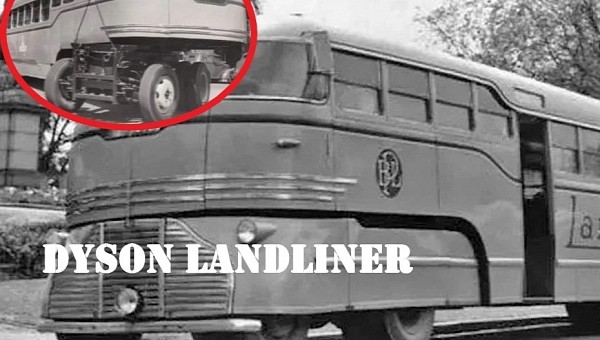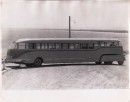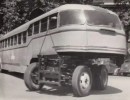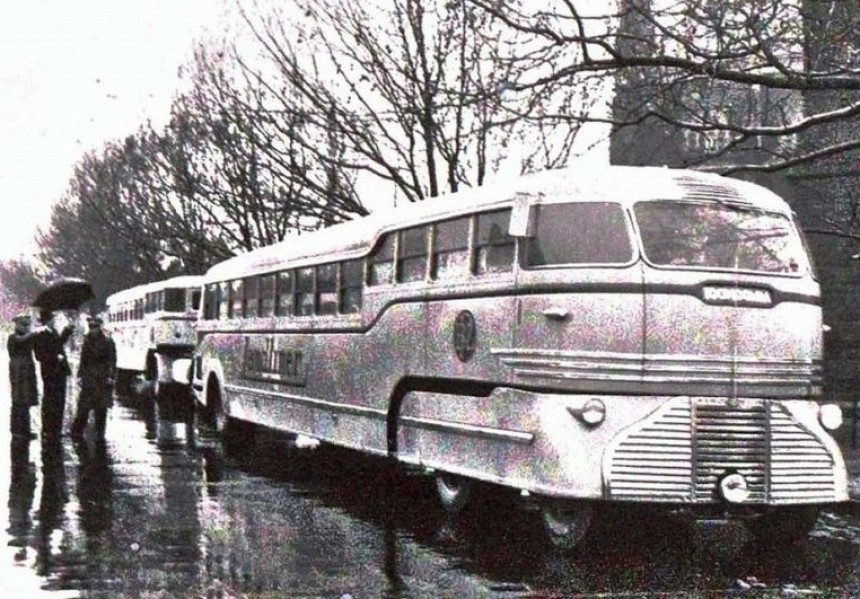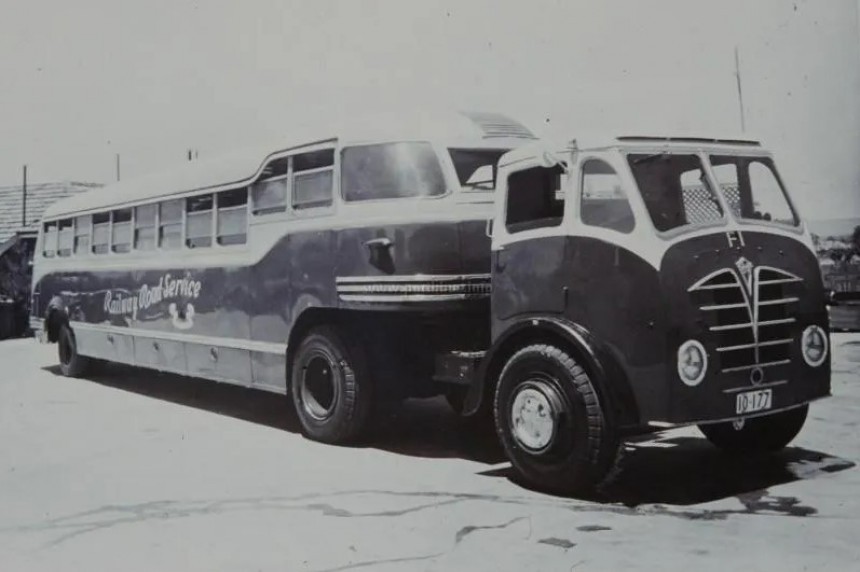Progress isn’t always possible by leaps and bounds, even though these are the occasions we tend to notice, especially these days. Progress means many hours of hard work, lots of trial and error, brainstorming, and more failures than anyone would care to count – or remember.
Every once in a while, a flop is so spectacular and so unlike anything else that it sits on the fine line between innovation and ridiculousness. The 6-wheel Dyson Landliner is one such failure, an innovative concept for a semi-tractor trailer bus that aimed to combine two Ford V8s placed on a hydraulically articulated front bogey for steering and ultra-deluxe features for the passengers.
Despite the name, the Landliner bears no relation to Dyson, the multinational company founded by James Dyson that started out by making vacuums and has since branched out into stuff like air-purifying masks and electric vehicles. This Dyson is Dyson’s Peninsula Motors Ltd, later shortened to just Peninsula Motors Ltd, a bus service in Frankston, Australia, which mostly ferried tourists arriving at the seaside town from Melbourne.
During WWII, Dyson’s buses were used to the maximum to carry troops from one military base to another, so the need for larger vehicles with a higher passenger capacity was pressing. This is when the semi-tractor trailer buses that had popped up in Australia in the ‘20s and ‘30s decades became even more popular, as they had the benefit of an easier and shorter construction period and boasted higher versatility, due to the possibility to elongate the trailer.
Starting from the idea of a semi-tractor trailer bus, Dyson’s created an innovative concept they would later call the Landliner. Instead of a prime mover, the bus used a hydraulically articulated steering bogey under the front of the coach, powered by two Ford V8 engines. The appeal of the concept must have been that, unlike your typical semi-tractor trailer bus, this was a much more streamlined design.
As innovative as the design was, it wasn’t exactly a novelty even back then. A similar concept had been unveiled years prior in the United States as the Victory Liner (or Victoryliner) from the Santa Fe Trailways. This one is often referred to as the largest bus in the world, since it could carry as many as 117 passengers, and it featured a similar steering arrangement.
The 4-wheel bogey in the Landliner was powered by two Ford flathead V8 engines arranged side by side, each with its own 4-speed transmission joined in a single linkage. Hydraulic steering and a steel marker on the front of the bogey that served as a visual cue for the driver regarding the wheels’ orientation aimed to make steering this beast a tad easier. Speaking of the driver, he was seated centrally in the cab for maximum visibility. But this was still a 45-foot (13.7-meter) bus with twin engines that would not always run in sync, so reliability and operability remained very low.
The Bus and Coach Society of Victoria believes that only one such Landliner was built, though conflicting reports claim several units were actually assembled and put into service, albeit in a very limited capacity. What they all agree on was that the first unit was the luxury model, with seating capacity for 30 people (upgradable to 60 in what would be later, standard versions) and the kind of features you’d find on a first-class plane trip.
These features included airplane-inspired reclining seats (of course!), carpeted floors, a refrigerator and the possibility to have tea onboard, a hostess that served said tea and snacks, an observation cabin, and a toilet. Sadly, no photos of the interior seem to have survived the passage of time.
The bus was registered as HG-640 by the Motor Registration Branch, but the Transport Regulation Branch would not allow Dyson’s to transport passengers in it. For the next two years, Dyson’s would lobby with politicians and local authorities to get the proper registration, but to no avail, so during this time, the Landliner only operated on a special permit and was used only on a handful of occasions. Reports in the media at the time claim the steering arrangement was so unreliable that the bus ran into a ditch at one point, but Dyson’s denied the story.
Either way, the publicity was enough to get the West Australian Government Railways to commission two such similar buses, which were called Cheetahs. They were in operation for a very short while, before the WAGR got tired of the problems the steering arrangement caused, so they were converted into traditional semi-tractor trailer buses with Foden prime movers. The original Landliner also went to the WAGR, leaving Frankston in 1947 by train.
All traces of the Dyson Landliner go dark that year, so whatever happened to it next is anybody’s guess. This innovative concept, which some consider ridiculously awesome and most would deem just plain ridiculous, is forever lost to time.
Despite the name, the Landliner bears no relation to Dyson, the multinational company founded by James Dyson that started out by making vacuums and has since branched out into stuff like air-purifying masks and electric vehicles. This Dyson is Dyson’s Peninsula Motors Ltd, later shortened to just Peninsula Motors Ltd, a bus service in Frankston, Australia, which mostly ferried tourists arriving at the seaside town from Melbourne.
During WWII, Dyson’s buses were used to the maximum to carry troops from one military base to another, so the need for larger vehicles with a higher passenger capacity was pressing. This is when the semi-tractor trailer buses that had popped up in Australia in the ‘20s and ‘30s decades became even more popular, as they had the benefit of an easier and shorter construction period and boasted higher versatility, due to the possibility to elongate the trailer.
As innovative as the design was, it wasn’t exactly a novelty even back then. A similar concept had been unveiled years prior in the United States as the Victory Liner (or Victoryliner) from the Santa Fe Trailways. This one is often referred to as the largest bus in the world, since it could carry as many as 117 passengers, and it featured a similar steering arrangement.
The 4-wheel bogey in the Landliner was powered by two Ford flathead V8 engines arranged side by side, each with its own 4-speed transmission joined in a single linkage. Hydraulic steering and a steel marker on the front of the bogey that served as a visual cue for the driver regarding the wheels’ orientation aimed to make steering this beast a tad easier. Speaking of the driver, he was seated centrally in the cab for maximum visibility. But this was still a 45-foot (13.7-meter) bus with twin engines that would not always run in sync, so reliability and operability remained very low.
These features included airplane-inspired reclining seats (of course!), carpeted floors, a refrigerator and the possibility to have tea onboard, a hostess that served said tea and snacks, an observation cabin, and a toilet. Sadly, no photos of the interior seem to have survived the passage of time.
The bus was registered as HG-640 by the Motor Registration Branch, but the Transport Regulation Branch would not allow Dyson’s to transport passengers in it. For the next two years, Dyson’s would lobby with politicians and local authorities to get the proper registration, but to no avail, so during this time, the Landliner only operated on a special permit and was used only on a handful of occasions. Reports in the media at the time claim the steering arrangement was so unreliable that the bus ran into a ditch at one point, but Dyson’s denied the story.
All traces of the Dyson Landliner go dark that year, so whatever happened to it next is anybody’s guess. This innovative concept, which some consider ridiculously awesome and most would deem just plain ridiculous, is forever lost to time.
